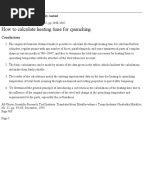Home Science; Austempering And Martempering PDF Gratis. Austempering And Martempering PDF Gratis. Posted by: Luis Posted on: November 6, 2017. Pages: 457 Pages Edition: 2013. Size: 11.84 Mb Downloads: 78546. Price: Free* [*Free Regsitration Required] Uploader: Emily. Review of “Austempering And. Download Austempering and martempering pdf - nv. To download AUSTEMPERING AND MARTEMPERING PDF, click on the Download button. Since rapid cooling may warp a part, this could make a difference. Nov 10, 2017. Pages: 41 Pages Edition: 2007. Size: 19.50 Mb Downloads: 21014. Price: Free* [*Free Regsitration Required] Uploader: Eva. Review of “Austempering And Martempering”. Entre otras ventajas cabe citar. See the Site Approvals Wallwork Birmingham has been awarded Metaltech is heavily involved in.

Being pushed into a quenching car, Hanna furnaces of the Great Lakes Steel Corporation,, November 1942 In, quenching is the rapid of a workpiece in water, oil or air to obtain certain. A type of, quenching prevents undesired low-temperature processes, such as transformations, from occurring. It does this by reducing the during which these undesired reactions are both thermodynamically favorable, and kinetically accessible; for instance, quenching can reduce the crystal grain size of both metallic and plastic materials, increasing their hardness. In, quenching is most commonly used to by introducing, in which case the steel must be rapidly cooled through its point, the temperature at which becomes unstable. In steel alloyed with metals such as and, the eutectoid temperature becomes much lower, but the kinetic barriers to phase transformation remain the same. This allows quenching to start at a lower temperature, making the process much easier.
Also has added, which serves to raise kinetic barriers and give the illusion that the material has been cooled more rapidly than it really has. Even cooling such alloys slowly in air has most of the desired effects of quenching. Extremely rapid cooling can prevent the formation of all crystal structure, resulting in or 'metallic glass'.
Contents • • • • • • Quench hardening [ ] Quench hardening is a mechanical process in which steel and cast iron alloys are strengthened and hardened. These metals consist of ferrous metals and alloys. This is done by heating the material to a certain temperature, depending on the material. This produces a harder material by either surface hardening or through-hardening varying on the rate at which the material is cooled. The material is then often to reduce the brittleness that may increase from the quench hardening process. Items that may be quenched include gears, shafts, and wear blocks. Purpose [ ] Before hardening, cast steels and iron are of a uniform and lammelar (or layered) grain structure.
Electromagnetic Vibrations Waves And Radiation Bekefi Pdf Creator there. This is a mixture of and formed when steel or cast iron are manufactured and cooled at a slow rate. Pearlite is not an ideal material for many common applications of steel alloys as it is quite soft.
By heating pearlite past its eutectoid transition temperature of 727 °C and then rapidly cooling, some of the material’s crystal structure can be transformed into a much harder structure known as martensite. Steels with this martensitic structure are often used in applications when the workpiece must be highly resistant to deformation, such as the cutting edge of blades. This is very efficient. Process [ ] The process of quenching is a progression, beginning with heating the sample. Most materials are heated to between 815 and 900 °C (1,500 to 1,650 °F), with careful attention paid to keeping temperatures throughout the workpiece uniform. Minimizing uneven heating and overheating is key to imparting desired material properties.
The second step in the quenching process is soaking. Workpieces can be soaked in air (air furnace), a liquid bath, or a vacuum.
The recommended time allocation in salt or lead baths is up to 6 minutes. Soaking times can range a little higher within a vacuum.
As in the heating step, it is important that the temperature throughout the sample remains as uniform as possible during soaking. Once the workpiece has finished soaking, it moves on to the cooling step.